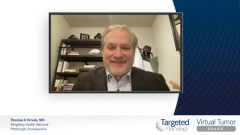
Case 1: Key Clinical Trials for PARP Inhibitors in Advanced Ovarian Cancer
Experts in gynecologic oncology review data and clinical implications for the use of PARP inhibitors from the GOG-0218, SOLO-1, PRIMA, and PAOLA-1 trials in advanced ovarian cancer.
Episodes in this series

Thomas C. Krivak, MD: Absolutely loved the discussion, and we brought up a lot of these trials. This is a slide from Dr Westin at MD Anderson [MD Anderson Cancer Center, Houston, Texas] and we thank her for it. This is a nice summary slide. GOG-0218, ICON7 led the way with using bevacizumab [Avastin], SOLO1, Dr Katie Moore [Kathleen N. Moore, The Stephenson Cancer Center, The University of Oklahoma] doing this trial, and this was a pivotal trial looking at patients with upfront ovarian cancer, BRCA mutated, somatic and germline, the majority of these were germline; and then obviously PRIMA and PAOLA trying to expand that indication. We touched on all these as we went through our recommendations. This slide highlights some of the similarities, but differences, and Dr Chan, you had mentioned that the PRIMA population is different than the SOLO population. You see stage III, stage IV is different, optimal, suboptimal is going to be different. I look at PAOLA, and for some reason, I don’t know why, but PAOLA, that 70/30, the number of optimals, interval dubulkings, even that 7% no surgery. We always said we operate on everybody, operate on everybody, and sometimes I go back, and I start to think did I really? I don’t think I operate on everybody. I think I operate on everybody who I think will do well with surgery. I operate on people who I think will do well with surgery that sometimes don’t do well. But when I don’t think they’re going to do well, I usually don’t. Ashley is laughing because she’s thinking that’s 1 in 1000. But I do think that we do not operate on some patients, and I think PRIMA and PAOLA are very nice and what we see in the clinic.
SOLO is a nice select population that shows us and helped lead the way with the development of upfront PARP therapy, and obviously there’s going to be some other clinical trials we’ll talk about later on and what’s coming up here. You can see the differences, 0218 was all-comers, they went back, and they looked at homologous recombination repaired genes retrospectively, and again SOLO-1 was germline and somatic complete or partial response. PRIMA was all-comers, and then PAOLA was all-comers, but the FDA [Food and Drug Administration] indication is for the homologous recombination deficient patients. This is a nice summary slide that shows some of the similarities, but differences, shows some of the timeframe differences for how long maintenance therapy was utilized, and again how we have to digest this information and apply it to each individual patient.
Again, looking at some of the PFS [progression-free survival] and hazard ratios. These are just tremendous. When you look at SOLO-1, having a hazard ratio of 0.33, and you look at that BRCA1 and [BRCA]2 mutation column, hazard ratio is 0.33; PRIMA, 0.4; PAOLA, 0.33 again; PAOLA having an active comparator, olaparib [Lynparza]/bev [bevacizumab (Avastin)] versus bevacizumab alone, and again SOLO and PRIMA have different patient populations. But looking at the homologous recombination proficient, which Dr Chan had brought up before, those patients definitely have poorer outcomes. You can see in PRIMA, if you were placed on maintenance therapy with placebo, you pretty much were almost going to be platinum resistant. Again, some of these patients started their treatment a month, 2 months, 3 months after, so their treatment-free interval, their platinum-free interval, may be between 6 and 9 months. But if you were treated without any type of maintenance, you were going to have potentially a platinum resistance.
But, again, when you look at these hazard ratios, they’re all very strong hazard ratios and favor maintenance therapy. Looking at PAOLA-1, where it did not get the FDA indication, had 0.92 at 16.9 versus 16 months in the HRP [homologous recombination proficiency] population. I must say that I was a bit surprised by that. I don’t know what the panel thinks about that outcome there, but I was a little bit surprised with respect to that not being positive a few years ago when we saw that presented at ESMO [European Society for Medical Oncology]. Any thoughts on these deltas or hazard ratios or anything between these 3 trials? Again, we’ve kind of talked about all this as we were going over the treatment plan for the patient with BRCA2 mutation.
Cecelia H. Boardman, MD: As you said, Tom, the data is so overwhelmingly in support of some type of maintenance therapy that I really feel that it is standard of care that we offer it to the patient and have a discussion about it. Obviously, we don’t mandate treatment, the patient has to make that choice, but I think it has changed the face of what we do and really looks to trying to extend that platinum-free window. I like that little cohort of patients in PRIMA, the HRD [homologous recombination deficiency] patients negative or the HRP population, and maintaining platinum sensitivity is important. For me, that is a patient population where I will look at niraparib [Zejula]. I would say to you I’m not surprised about PAOLA-1 and the HRP population, and I think that goes back to the PRIMA data, but also, honestly, goes back to the pharmacokinetics of the drug. Niraparib has a longer half-life. It has higher tissue distribution. In my mind, that may be the pharmacokinetics behind why you see that difference with PRIMA, but you don’t see it in PAOLA-1 in the HRP population. They’re not the same drug.
Thomas C. Krivak, MD: That’s a very good point, very good point. Dr Chan, any thoughts?
John K. Chan, MD: I like what you said, Tom, with respect to hazard ratios. Looking at this slide that you’re showing us here, you got hazard ratio of 0.3. We’ve never seen that, never, in our ovarian cancer trials, whether you look at GOG-0218, you look at our intraperitoneal trials that we’re very familiar with. All those are positive. Even when we brought taxanes on board, right, into the medical oncology community, we’ve never seen hazard ratios like this. It’s interesting that even in the BRCA-positive breast cancer, prostate cancer, pancreatic cancer, they’re not seeing these benefits. Our tumors just outshine them in terms of its performance after exposure to these PARP inhibitors. To not offer these drugs to our patients, it’s a shame. These patients, especially the BRCA1 and even the HRD-positive patients, should get these maintenance strategies. The proficient group, I can see where there needs to have a discussion between the patients and the providers.
But I think of it this way. I like what Cecelia said with respect to the fact that even though you’re not getting a big delta of a difference in the HR proficient group, these patients, you are bringing them from the class of platinum resistance to the platinum sensitive, not that these drugs are making these tumors more sensitive, that’s not what we’re saying here. What we’re saying is that when you’ve pushed these patients from a category majority, right, the median from 5 months to 8 months let’s say in the HR proficient group in the PRIMA study, you did bring them into a platinum-sensitive category, where you can offer them platinum again, where you can actually give them a doublet and Avastin, like OCEANS or GOG-0213. For those patients, you are giving them the ability to get re-exposed to platinum again, and hopefully get a longer response, more response, and a longer duration of response.
Thomas C. Krivak, MD: That’s a good point as well. This is really impressive data, and again it’s hard to digest all this as we’re going through this. Again, I look at this and I always say, I know that we always talk about SOLO, and I think SOLO-1 is important, but in this patient who had a BRCA2 mutation, niraparib is still a viable option. I always think that niraparib went after difficult-to-treat, looking at QUADRA, looking at NOVA, how they branched out into the HRP population there. To me, I always think that olaparib or BRCA1 and BRCA2 mutations, but we need to give credit to niraparib as well. They have a strong hazard ratio as well within this subgroup and not just think about them for the HRP patients as well. But, again, it’s tremendous data and it’s great to have these discussions, and I’m sure ongoing clinical development of these medications and combos, we’re going to have great data to review again.
We talked about the adverse effect profile. Again, I think it was nice how Dr Boardman had said let’s look at the anemia and we could switch over to niraparib and go back and forth. But what you can see is that you do have some nausea and some vomiting, fatigue with olaparib. When you look at niraparib, you have some anemia, some thrombocytopenia. And then the combination of olaparib/bevacizumab a little bit more hypertension. But there seems to be a little bit of difference within the adverse effect profile, and again how we may start somebody on a medication and want to keep them on it for the duration, if we need to change to another medication, this tells us that we can do it because some of the differences with respect to the adverse effects.
We all know the adverse effects with respect to these medications and just like Ashley was mentioning, we’re developing protocols to help manage adverse effects, nausea, vomiting, diarrhea, fatigue, those kind of things, and really having these medications out in clinical utility for the last 5 to 6 years has helped greatly.
Transcript Edited for Clarity











































